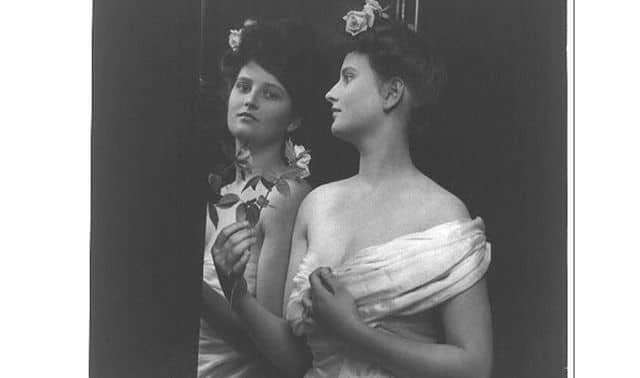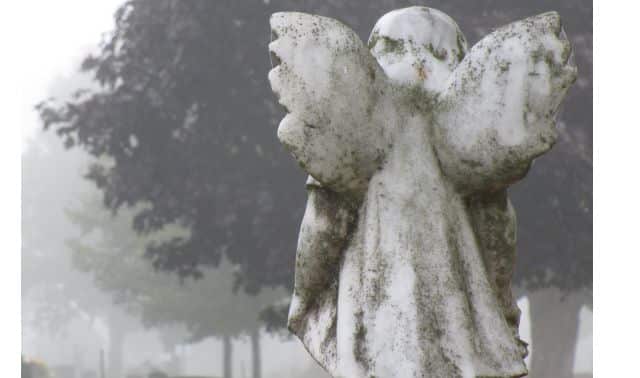Sign up for the Family Tree Newsletter! Plus, you’ll receive our 10 Essential Genealogy Research Forms PDF as a special thank you.
Get Your Free Genealogy Forms
"*" indicates required fields
Long before selfies, Narcissus famously became transfixed by his own reflection in a pool of water. The mythical Greek youth can be forgiven for his, well, narcissism, as the only way to see your own face for most of human history was the occasional glimpse in a puddle or on a shiny rock.
These days, mirrors are so common place that a home would seem very strange without them. They’re an important part of our daily routine, a means of assurance that we are ready to go out and face the world. But how long have mirrors existed? Where did they come from? Read on to explore the history of mirrors.
A History of Mirrors
The earliest known manufactured mirrors are 8,000 years old. Found in Anatolia in southern Turkey, they were made from obsidian, a natural black volcanic glass and measured a little less than four inches in diameter. They provided a surprisingly clear—if hauntingly dark—reflection. Mesopotamians who wanted to see themselves made mirrors from polished copper about 4000 BC, as did Egyptians about a thousand years later. Later Egyptians, during the Ptolemaic period (305 to 30 BC), fashioned small round glass mirrors by cutting and piecing spheres of blown glass.
As those Egyptians discovered, glass provides the flat smoothness required for a mirror, but it’s not very reflective without a shiny backing. They applied lead, tin, antimony or later, silver and deadly mercury to make the glass reflective.
By the first century, Greek mirror-makers could assemble enough glass tiles on cast lead forms to create mirrors large enough to view one’s entire body. Most mirrors were much smaller, however, less than a foot in diameter. They were built with an eyelet for hanging, an easel-like stand or a boxed metal cover for carrying, like oversize cosmetic compacts. Reflections still tended to be dim—in the words of the Apostle Paul, “For now we see through a glass, darkly.”
The Romans spread glass-making throughout their empire, but their mirrors remained relatively crude. They called the mirror speculum, from specere, meaning “to look” or “behold.” Our modern word mirror derives from the Latin mirari, “to admire,” which became the French mirour.
Renaissance Reflections
After the fall of the Roman Empire, the Chinese carried the mirror-making torch, backing glass mirrors with silver as early as 500 AD. They coated glass with an amalgam of silver and mercury, then heated until the mercury boiled away.
European craftsmen later experimented with large mirrors fabricated from rock crystal. As rare and expensive as gemstones, crystal mirrors were prized among the wealthy and royal. Francis I of Mantua (1382-1407) installed them in his Castle of San Giorgio.
Meanwhile, glassmakers experimented with various additions—limestone, potash, manganese—that produced clearer glass. French craftsmen developed the technique of blowing large molten glass bubbles and then rapidly spinning them to flatten the orbs into plates. During the early Renaissance, a superior backing of tin and mercury made mirrors more reflective with less heat shock to the glass.
These improved mirrors affected everything from Renaissance art to one’s sense of self as an individual. In addition to making the self-portrait possible, mirrors contributed to Filippo Brunelleschi’s 1425 discovery of linear perspective.
Mirror Monopoly
Venice provided cutting-edge mirror-making technologies in the 16th century, so tightly holding its glassmaking secrets that the most skilled artisans were locked away on the island of Murano. They labored in sweltering, dangerous conditions, tending volatile furnaces and exposing themselves to mercury (not yet recognized as dangerous). The Venetian “cristallo” glass formula and tin-mercury backing created mirrors of unprecedented quality. Secret ingredients included the local quartz pebbles, of an unusually pure silica that could be ground into perfect sand, and soda ash from the Levant in the eastern Mediterranean.
A century of industrial espionage and experimentation failed to crack the Venetian mirror monopoly. As a result, mirrors were—sometimes literally—worth their weight in gold. England’s King Henry VIII and France’s Francis I were both avid mirror collectors, to the detriment of their nations’ treasuries. A typical Venetian mirror, no bigger than 40 square inches, could cost as much as an aristocrat’s country estate. The Countess de Fiesque reportedly exchanged an entire wheat farm for a single mirror—and considered it a bargain.
Finally, the French minister of finance, Jean-Baptiste Colbert, managed to spirit away several Murano glassmakers in hopes of reducing the 100,000-crown annual trade deficit for Italian mirrors. With the support of Louis XIV, he established a factory at Saint-Gobain. Among its first projects, begun in 1678, would be the 357 mirrors installed in the Hall of Mirrors at the Sun King’s palace at Versailles.
Breakable Breakthroughs
Even with the Venetians’ secrets revealed, glass production remained complex and expensive. Mirrors—like glass windows—were still out of reach of the average household’s budget. Then the addition of lead oxide to molten glass, pioneered in1674 England by George Ravenscroft, both improved the appearance of the glass and extended the “working period” during which it could be formed. Ravenscroft also experimented with alternatives to the Venetians’ silica, and eventually his tinkering helped England’s glass industry to overtake Italy’s.
Plate glass, made by rolling molten glass on a cast-iron bed, was first made commercially in 1832 by the British Crown Glass Co. Later, Joseph Paxton would use the technology to build London’s famed Crystal Palace for the Great Exhibition of 1851.
In 1835, German chemist Justus von Liebig discovered that a layer of silver nitrate spread on a sheet of glass could be chemically reduced to leave only a thin silver backing. His process, combined with innovations in the production of plate glass, enabled the manufacture of mirrors on an industrial scale. Today, the wet disposition of silver or aluminum directly onto glass has replaced von Liebig’s process.
For the first time in history, ordinary people could see their own reflection whenever they fancied, no reflecting pool needed.
Timeline of the Mirror
6000 BCE | Obsidian mirrors are made in Anatolia
1291 | Venice orders glass-makers to move to Murano
1373 | First guild of mirror-makers is formed in Nuremberg
1678 | Construction begins on the Hall of Mirrors at Versailles
1721 | James Bradley uses mirrors to make the first reflecting telescope
1835 | Justus von Liebig develops silvering process for mirrors
1871 | Lewis Carroll writes Through the Looking-Glass, and What Alice Found There
1937 | A magic mirror gives away Snow White to the Evil Queen
2004 | “Mythbusters” debunks the tale of Archimedes’ mirror-focused “death ray”
Fun Facts and Superstitions About Mirrors
- The superstition that breaking a mirror brings seven years of bad luck dates to the ancient Romans, who believed it took seven years for a soul to be renewed. One might avoid the curse, they thought, by burying all the broken pieces deeply in the ground.
- The early Catholic Church forbade its priests to own mirrors, considering them objects of vanity and sin. Pope John XII (937-964) warned, “The Devil can conceal himself in a phial or a mirror.”
- The ancient Aztecs used metal mirrors to concentrate sunlight and start fires, as well as to decorate their clothing and headgear. The god Tezcatlipoca’s name means “smoking mirror.”
- Archimedes was said to have used bronze mirrors to focus the sun’s rays and set fire to a Roman fleet attacking Syracuse.
Last updated, October 2023








